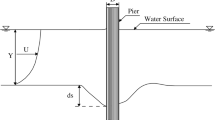Abstract
This paper uses the recently proposed grasshopper optimization algorithm (GOA) to develop a new hybrid, stochastic training algorithm for the feed-forward neural networks (FFNN). The state-of-the-art hybrid model is then applied to study observing pattern of scour depth which is a challenging problem in hydraulic engineering. In order to verify and control the accuracy, stability, and efficiency of the proposed model and its computational process, the model results are compared to networks trained by three different training algorithms. To achieve this, backpropagation, backpropagation with momentum, and Levenberg–Marquardt learning algorithms, which are widely used for various hydraulic problems, are chosen. The results of the model indicated that the proposed model has high stability and performance in solving regression problems. The comparison of prediction accuracy and convergence curves represented that the model could predict the maximum scour depth with the higher convergence speed. Applying the proposed model improves the correlation coefficient (R), root mean square error (RMSE), and mean absolute error (MAE) values by approximately 6%, 30%, and 18%, respectively.








Similar content being viewed by others
References
Richardson EV, Davis SR (1995) Evaluating scour at bridges (HEC-18). US Department of Transportation, Federal Highway Administration, Office of Bridge Technology. Colorado, 4th edn. FHWA NHI, pp 01–001
McIntosh JL (1989) Use of scour prediction formulae. In Proceedings of the Bridge Scour Symposium, McLean, VA, Federal Highway Administration Research Report FHWA-RD-90–035, pp 78–100
Bateni SM, Borghei SM, Jeng DS (2007) Neural network and neuro-fuzzy assessments for scour depth around bridge piers. Eng Appl Artif Intell 20(3):401–414
Firat M, Gungor M (2009) Generalized regression neural networks and feed forward neural networks for prediction of scour depth around bridge piers. Adv Eng Softw 40(8):731–737
Toth E, Brandimarte L (2011) Prediction of local scour depth at bridge piers under clear-water and live-bed conditions: comparison of literature formulae and artificial neural networks. J Hydroinf 13(4):812–824
Kaya A (2010) Artificial neural network study of observed pattern of scour depth around bridge piers. Comput Geotech 37(3):413–418
Ojha VK, Abraham A, Snášel V (2017) Metaheuristic design of feedforward neural networks: a review of two decades of research. Eng Appl Artif Intell 60:97–116
Hamidzadeh J, Namaei N (2019) Belief-based chaotic algorithm for support vector data description. Soft Comput 23(12):4289–4314
Hamidzadeh J, Sadeghi R, Namaei N (2017) Weighted support vector data description based on chaotic bat algorithm. Appl Soft Comput 60:540–551
Saremi S, Mirjalili S, Lewis A (2017) Grasshopper optimisation algorithm: theory and application. Adv Eng Softw 105:30–47
Heidari AA, Faris H, Aljarah I, Mirjalili S (2019) An efficient hybrid multilayer perceptron neural network with grasshopper optimization. Soft Comput 23(17):7941–7958
Heidari AA, Abbaspour RA (2018) Enhanced chaotic grey wolf optimizer for real-world optimization problems: a comparative study. In Handbook of Research on Emergent Applications of Optimization Algorithms. IGI Global pp 693–727
Aljarah I, Faris H, Mirjalili S (2018) Optimizing connection weights in neural networks using the whale optimization algorithm. Soft Comput 22(1):1–15
Faris H, Aljarah I, Mirjalili S (2016) Training feedforward neural networks using multi-verse optimizer for binary classification problems. Appl Intell 45(2):322–332
Esteva A, Kuprel B, Novoa RA, Ko J, Swetter SM, Blau HM, Thrun S (2017) Dermatologist-level classification of skin cancer with deep neural networks. Nature 542(7639):115–118
Trujillo MCR, Alarcón TE, Dalmau OS, Ojeda AZ (2017) Segmentation of carbon nanotube images through an artificial neural network. Soft Comput 21(3):611–625
Haykin S (1999) Neural networks: a comprehensive foundation. Prentice-Hall, Englewood Cliffs
Bhattacharya B, Price RK, Solomatine DP (2007) Machine learning approach to modeling sediment transport. J Hydraul Eng 133(4):440–450
Topaz CM, Bernoff AJ, Logan S, Toolson W (2008) A model for rolling swarms of locusts. Eur Phys J Spec Top 157(1):93–109
Azmathullah HM, Deo MC, Deolalikar PB (2005) Neural networks for estimation of scour downstream of a ski-jump bucket. J Hydraul Eng 131(10):898–908
Legates DR, McCabe GJ Jr (1999) Evaluating the use of “goodness-of-fit” measures in hydrologic and hydroclimatic model validation. Water Resour Res 35(1):233–241
Kaveh K, Bui MD, Rutschmann P (2017) A comparative study of three different learning algorithms applied to ANFIS for predicting daily suspended sediment concentration. Int J Sedim Res 32(3):340–350
Heidari AA, Delavar MR (2016) A modified genetic algorithm for finding fuzzy shortest paths in uncertain networks. Int Arch Photogramm Remote Sens Spat Inf Sci 41
Seiffert U (2001) Multiple layer perceptron training using genetic algorithms. In ESANN. pp 159–164
Funding
This research was partly funded by Fulbright US-ASIAN Visiting Scholar Program (G-1–00005) for Duong Tran Anh at University of South Florida, USA (N0031836361).
Author information
Authors and Affiliations
Contributions
K.K. and D.T.A designed the study, processed, and analyzed the data, developed the models, interpreted the results, and wrote the paper. D.N.N and Q.B.P check the methodology and proofreading and finalize the manuscript.
Corresponding author
Ethics declarations
Conflict of interest
The authors declare no competing interests.
Additional information
Responsible Editor: Zeynal Abiddin Erguler
Highlights
• A novel hybrid stochastic training algorithm was developed for FFNN;
• New computational strategies and numerical algorithms in neural networks;
• The accuracy, stability, and efficiency of the model was controlled and proven;
• The proposed model shows efficient and accurate compared to other existing models.
Rights and permissions
About this article
Cite this article
Kaveh, K., Mai, D.N., Pham, Q.B. et al. A hybrid feed-forward neural network with grasshopper optimization for observing pattern of scour depth around bridge piers. Arab J Geosci 14, 2352 (2021). https://doi.org/10.1007/s12517-021-08617-8
Received:
Accepted:
Published:
DOI: https://doi.org/10.1007/s12517-021-08617-8




